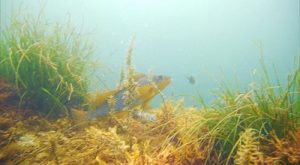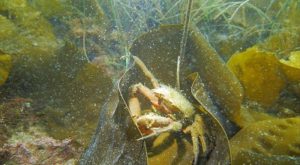Current Project Status
Since 2017, the SeaChange Marine Conservation Society has been leading the Salish Sea Nearshore Habitat Recovery Project in an effort to restore eelgrass to four regions, including Howe Sound, Sechelt Inlet, the southern Gulf Islands and Burrard Inlet. In fall 2021, more than 25 volunteers helped prepare 2,393 shoots of eelgrass for transplant in Gibsons Harbour and Cotton Bay on Gambier Island.
In fall 2020, SeaChange, together with in-kind support from the Town of Gibsons and the SCRD (Sechelt Landfill), removed 1.75 tonnes of debris from Plumper Cove Marine Park on Keats Island. They returned in September 2021 and again removed significant amounts of debris from the ocean floor. SeaChange is now working with BC Park to develop a more proactive approach to prevent waste being dumped in the area.
Additionally, SeaChange is collaborating with the Nicholas Sonntag Marine Education Centre and the Town of Gibsons to institute a voluntary no-anchor zone in the Gibsons Marina.
As at September 2021, marker buoys for a voluntary “no anchor zone” have been developed, with 5 buoys proposed to mark a zone along Armours Beach. The marker buoys are expected to be installed in the first quarter of 2022. Read more: Project Healthy Harbour.
Read the Eelgrass Protection Voluntary No-Anchor Zone fact sheet here.
Background
What is Eelgrass?
 Eelgrass is a type of submerged aquatic vegetation (referred to as SAV) that grows in estuaries and shallow bays. Eelgrass is not a seaweed – it is a perennial flowering plant.
Eelgrass is a type of submerged aquatic vegetation (referred to as SAV) that grows in estuaries and shallow bays. Eelgrass is not a seaweed – it is a perennial flowering plant.
Seagrass ecosystems are among the most diverse and productive ecosystems in the world. In ecological and economic value, they rival tropical rainforests and the world’s richest farmlands. Additionally, eelgrass beds are recognized as “nursery” areas for many marine and anadromous species. Eelgrass provides food, shelter and protection from predators for many juvenile fish and shellfish of ecological, commercial and recreational importance.
Why Monitor Eelgrass?
A viable and self-sustaining SAV population is an indicator of a healthy estuary (in estuaries that naturally support SAV). By monitoring the occurrence of SAV beds and the changes in their distribution, density, and species composition, trained volunteers can help determine the health and status of SAV in an estuary. Scientists can then compare this information to historical data of SAV beds and monitor changes.
In 2013, Dianne Sanford, the Sunshine Coast Regional District, and the Department of Fisheries and Oceans began mapping eelgrass beds in the Gibsons Marina. View the resulting Eelgrass Mapping Report. In February 2014, Dianne provided a PowerPoint presentation to Council on the topic. View the presentation here.
Additional Resources 
View a short video about eelgrass: Salish Sea Oceancast.
The Province, Vancouver Island University and Comox Valley Project Watershed Society have signed a Memorandum of Understanding (MOU) and identified opportunities – starting in the Comox Valley – for these blue carbon projects in B.C – read more: http://projectwatershed.ca/unlocking-coastal-bcs-blue-carbon-opportunities/
David Suzuki Foundation – Nearshore Natural Capital Valuation

